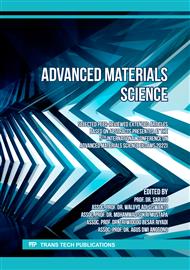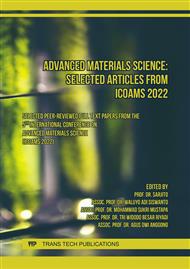[1]
M. Ahmaruzzaman, D.K. Sharma, Adsorption of phenols from wastewater, J. Colloid Interface Sci. 287 (2005) 14–24.
DOI: 10.1016/j.jcis.2005.01.075
Google Scholar
[2]
D.W. Astuti, N.H. Aprilita, M. Mudasir, ADSORPTION OF THE ANIONIC DYE OF CONGO RED FROM AQUEOUS SOLUTION USING A MODIFIED NATURAL ZEOLITE WITH BENZALKONIUM CHLORIDE, Rasayan J. Chem. 13 (2020) 845–853.
DOI: 10.31788/rjc.2020.1325537
Google Scholar
[3]
N. Begum, A. Noorliyana, M.F. Bari, N.A. Halif, N. Hidayah, K.R. Ahmed, Kinetic and Thermodynamic Studies on Adsorption of Copper Ions onto Pomelo Peel (Citrus grandis), Adv. Mater. Res. 795 (2013) 674–678.
DOI: 10.4028/www.scientific.net/amr.795.674
Google Scholar
[4]
W. Chai, X. Liu, J. Zou, X. Zhang, B. Li, T. Yin, Pomelo peel modified with acetic anhydride and styrene as new sorbents for removal of oil pollution, Carbohydr. Polym. 132 (2015) 245–251.
DOI: 10.1016/j.carbpol.2015.06.060
Google Scholar
[5]
Y. Chen, Y. Liu, Y. Li, Y. Chen, Y. Wu, H. Li, S. Wang, Z. Peng, R. Xu, Z. Zeng, Novel Magnetic Pomelo Peel Biochar for Enhancing Pb(II) And Cu(II) Adsorption: Performance and Mechanism, Water. Air. Soil Pollut. 231 (2020).
DOI: 10.1007/s11270-020-04788-4
Google Scholar
[6]
V.P. Dinh, T.D.T. Huynh, H.M. Le, V.D. Nguyen, V.A. Dao, N.Q. Hung, L.A. Tuyen, S. Lee, J. Yi, T.D. Nguyen, L. V. Tan, Insight into the adsorption mechanisms of methylene blue and chromium(III) from aqueous solution onto pomelo fruit peel, RSC Adv. 9 (2019) 25847–25860.
DOI: 10.1039/c9ra04296b
Google Scholar
[7]
G. Dursun, H. Çiçek, A.Y. Dursun, Adsorption of phenol from aqueous solution by using carbonised beet pulp, J. Hazard. Mater. 125 (2005) 175–182.
DOI: 10.1016/j.jhazmat.2005.05.023
Google Scholar
[8]
S.-W. Liew, S.-T. Ong, Removal of Basic Blue 3 Dye Using Pomelo Peel, Asian J. Chem. 26 (2014) 3808–3814.
DOI: 10.14233/ajchem.2014.15945
Google Scholar
[9]
Z. Liu, K. Xing, Removal of Acid Red 88 Using Activated Carbon Produced from Pomelo Peels by KOH Activation : Orthogonal Experiment , Isotherm , and Kinetic Studies, 2021 (2021).
DOI: 10.1155/2021/6617934
Google Scholar
[10]
R. Mallampati, L. Xuanjun, A. Adin, S. Valiyaveettil, Fruit Peels as Efficient Renewable Adsorbents for Removal of Dissolved Heavy Metals and Dyes from Water, ACS Sustain. Chem. Eng. 3 (2015) 1117–1124.
DOI: 10.1021/acssuschemeng.5b00207
Google Scholar
[11]
S.M. Mirsoleimani-azizi, P. Setoodeh, S. Zeinali, M.R. Rahimpour, Tetracycline antibiotic removal from aqueous solutions by MOF-5: Adsorption isotherm, kinetic and thermodynamic studies, J. Environ. Chem. Eng. 6 (2018) 6118–6130.
DOI: 10.1016/j.jece.2018.09.017
Google Scholar
[12]
P. Nowicki, J. Kazmierczak-Razna, R. Pietrzak, Physicochemical and adsorption properties of carbonaceous sorbents prepared by activation of tropical fruit skins with potassium carbonate, Mater. Des. 90 (2016) 579–585.
DOI: 10.1016/j.matdes.2015.11.004
Google Scholar
[13]
Y.Y. Pei, J.Y. Liu, Adsorption of Pb2+ in Wastewater Using Adsorbent Derived from Grapefruit Peel, Adv. Mater. Res. 391–392 (2011) 968–972.
DOI: 10.4028/www.scientific.net/amr.391-392.968
Google Scholar
[14]
Y. Ren, C. Cui, P. Wang, Pomelo peel modified with citrate as a sustainable adsorbent for removal of methylene blue from aqueous solution, Molecules. 23 (2018).
DOI: 10.3390/molecules23061342
Google Scholar
[15]
R.K. Singh, S. Kumar, S. Kumar, A. Kumar, Development of parthenium based activated carbon and its utilization for adsorptive removal of p-cresol from aqueous solution, J. Hazard. Mater. 155 (2008) 523–535.
DOI: 10.1016/j.jhazmat.2007.11.117
Google Scholar
[16]
P. T.K.M., S.K. Ashok Kumar, S.K. Sahoo, A quick removal of toxic phenolic compounds using porous carbon prepared from renewable biomass coconut spathe and exploration of new source for porous carbon materials, J. Environ. Chem. Eng. 6 (2018) 1434–1442.
DOI: 10.1016/j.jece.2018.01.051
Google Scholar
[17]
M. Torab-Mostaedi, M. Asadollahzadeh, A. Hemmati, A. Khosravi, Biosorption of lanthanum and cerium from aqueous solutions by grapefruit peel: equilibrium, kinetic and thermodynamic studies, Res. Chem. Intermed. 41 (2015) 559–573.
DOI: 10.1007/s11164-013-1210-4
Google Scholar
[18]
L. Trakal, V. Veselská, I. Šafařík, M. Vítková, S. Číhalová, M. Komárek, Lead and cadmium sorption mechanisms on magnetically modified biochars, Bioresour. Technol. 203 (2016) 318–324.
DOI: 10.1016/j.biortech.2015.12.056
Google Scholar
[19]
X.L. Yu, Y. He, Optimal ranges of variables for an effective adsorption of lead(II) by the agricultural waste pomelo (Citrus grandis) peels using Doehlert designs, Sci. Rep.8 (2018) 1–9.
DOI: 10.1038/s41598-018-19227-y
Google Scholar
[20]
B. Zhang, Y. Wu, L. Cha, Removal of methyl orange dye using activated biochar derived from pomelo peel wastes : performance , isotherm , and kinetic studies, J. Dispers. Sci. Technol. 0 (2019) 1–12.
DOI: 10.1080/01932691.2018.1561298
Google Scholar



